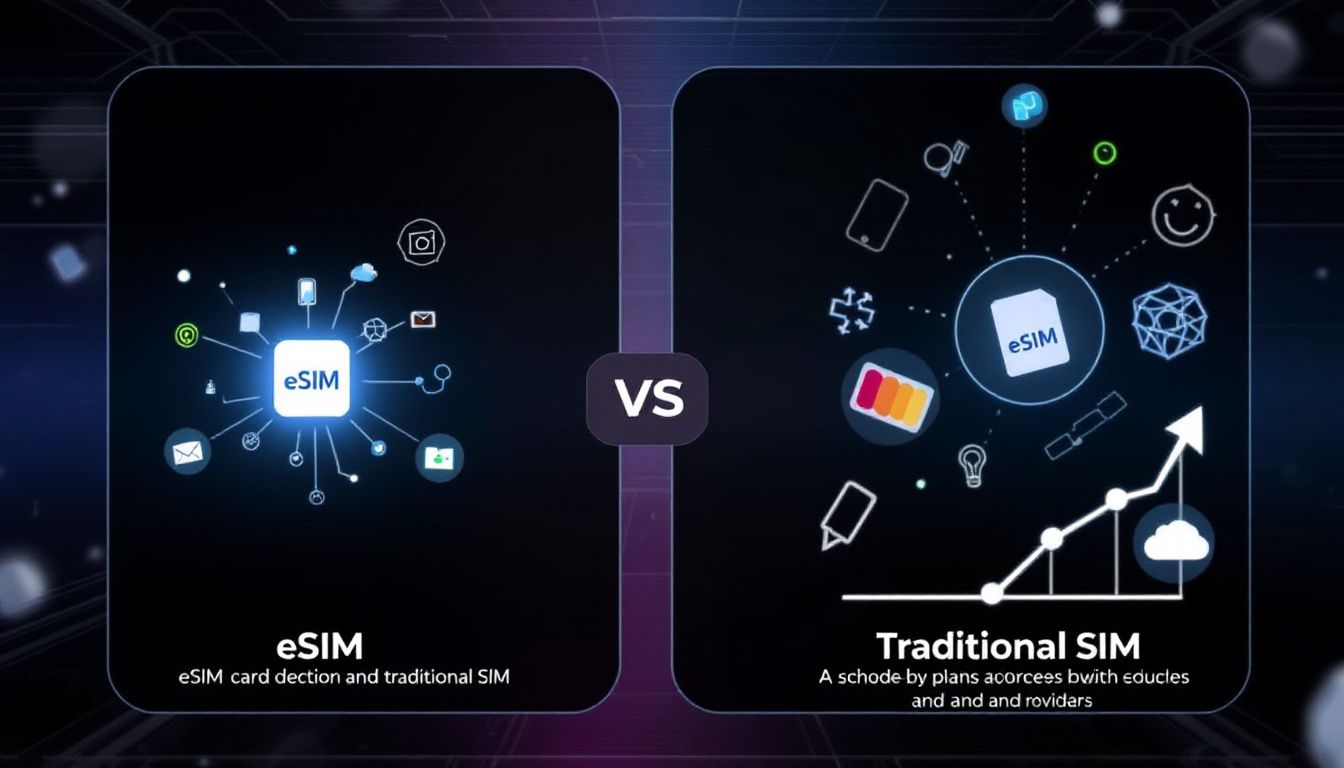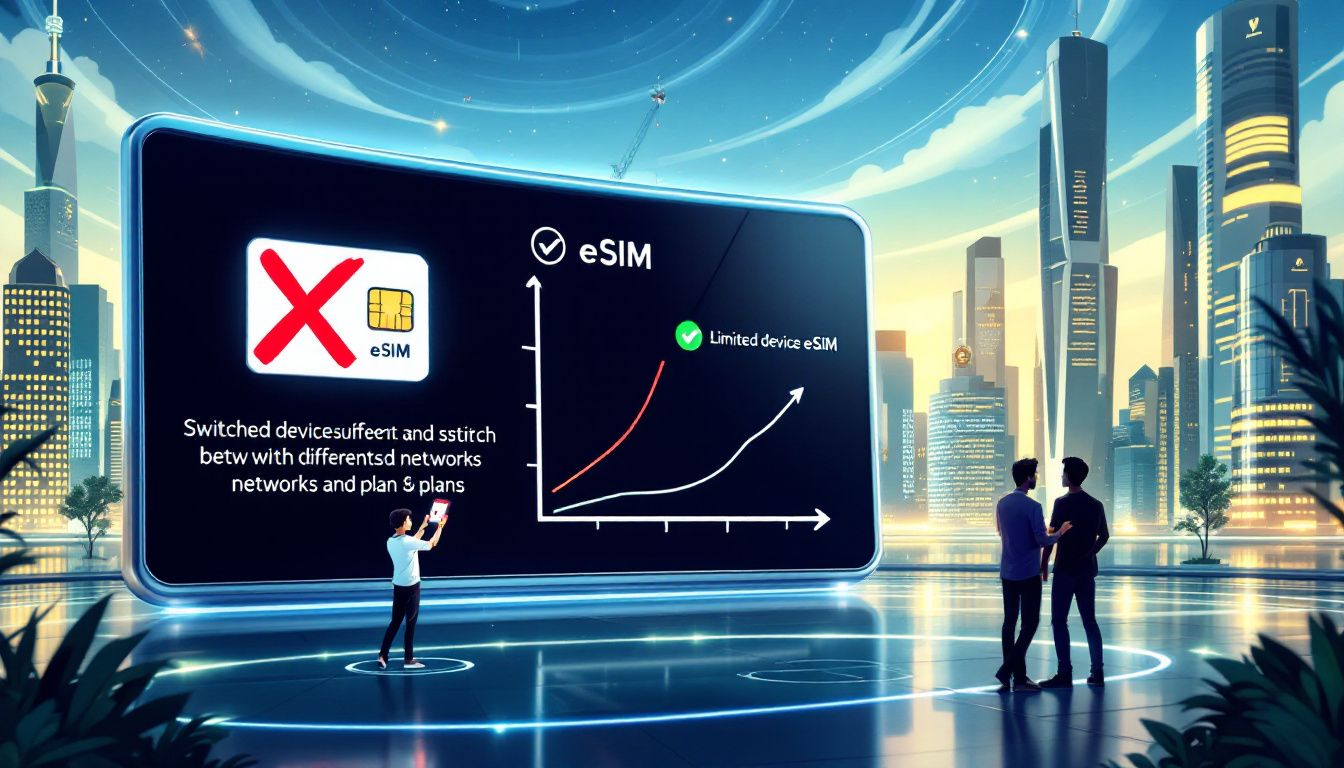
Are eSIMs Reliable? Exploring Pros, Cons, and Performance Insights
Share
Are eSIMs Reliable? Pros and Cons Explained
Are eSIMs reliable? Yes, eSIMs eliminate the risk of physical damage and offer strong security features, making them a dependable choice. This article explores the key factors that impact the reliability of eSIMs like network coverage, security, and compatibility.
Key Takeaways
-
eSIMs offer convenience by allowing users to switch networks and activate plans online without needing a physical SIM card.
-
Security is enhanced with eSIMs, as they are embedded in devices, reducing risks like tampering or theft compared to traditional SIMs.
-
Despite their advantages, eSIMs face challenges with limited device compatibility and potentially complex activation processes.
Understanding eSIM Technology

Embedded SIM, often referred to as eSIM technology, marks a substantial advancement from conventional physical sim cards. An esim card is integrated within the device itself, which eliminates the necessity for swapping out physical sim cards when changing network services. This innovative approach allows devices to be provisioned and managed remotely—enabling users to activate or switch their mobile plans without having to physically visit a store or wait for a new physical sim card.
The impact of eSIM technology extends beyond smartphones. It’s being incorporated into an array of gadgets like laptops, tablets, and vehicles. Predictions indicate that by 2030 approximately 70% of phones will support eSim functionality—a testament to its increasing prominence in the market. Apple has been instrumental in advancing this trend with its introduction of eSIM on models starting from iPhone XS onwards.
One remarkable aspect of embedded sims is their ability to store multiple profiles simultaneously on one device. This provides increased versatility for individuals who can maintain distinct profiles dedicated for professional use, personal activities or while traveling—all conveniently accessible through downloadable activations without requiring any tangible swap outs typical with traditional Sim Cards systems.
Reliability Factors of eSIMs

The embedded design of eSIMs provides a more reliable service when compared to traditional sim cards. Their integration directly within the device mitigates the chance of loss or damage, ensuring that support for esim maintains continuous network connectivity and enhances stability with the use of eSIM cards.
Because there is no physical card involved, issues related to traditional SIM degradation over time are eliminated.
Network Coverage and Signal Strength
Signal strength is crucial for the proper functioning of mobile technology, which applies to eSIMs as well. The performance and reachability of eSIM services can differ greatly from one area to another, contingent on how well-established and supportive the network provider in that region is. It’s noteworthy that both eSIMs and traditional SIM cards rely equally on cellular network infrastructure when it comes to signal quality.
Both physical sim cards and their electronic counterparts are influenced by various elements such as proximity to a cell tower, environmental barriers, and the caliber of a device’s antenna. An advantage provided by eSIMs is their ability to seamlessly switch over to the most robust local mobile network automatically while roaming—this feature significantly improves connectivity for those who travel often across different areas with varying network coverage.
Security Features of eSIMs
In terms of security, eSIMs present multiple enhancements over traditional sim cards. The embedded design within the device means that they can’t be physically taken out or misplaced, greatly diminishing the risks associated with tampering and theft. Due to their non-removable nature, it becomes substantially more difficult for cybercriminals to execute SIM swap attacks—a prevalent issue linked with traditional SIM cards.
Any updates to a user’s profile on an eSIM require confirmation from the network operator, which provides an added level of security protection. Certain eSIM variants are even equipped with a special safeguard referred to as self-destructing DNA. This feature is designed to delete information after numerous unsuccessful attempts at authentication have been made. These heightened security protocols establish eSims as a safer alternative in contrast to physical sim card counterparts.
Device Compatibility
When considering the implementation of eSIM technology, it’s essential to ensure device compatibility. Support for eSIM is commonly found in newer high-end smartphones. Many older models lack this capability. A significant number of recent Apple products and several new Android devices are equipped with support for eSIM technology. Notably, the iPhone XS series was at the forefront in embracing eSIM.
For those looking to ascertain whether their Android device can work with an eSIM, reaching out to either their carrier or phone manufacturer is advisable due to varying levels of service availability by region. Carriers frequently facilitate access to eSim services through different methods such as scanning a QR code or using dedicated carrier applications.
Benefits of Using an eSIM

Utilizing an eSIM provides a multitude of advantages, from heightened convenience to potential advancements in device design. One key benefit includes the capacity for online mobile plan activation, bypassing the need for a physical retail presence—a feature that is particularly advantageous to those who regularly switch between carriers or engage in international travel.
In contrast to traditional physical sim cards, eSIMs offer superior resilience as they are not susceptible to the same risks of damage or misplacement due to their embedded nature. This integration also contributes to more space within devices, potentially paving the way for slimmer designs and Technological improvements.
ESIMs possess the capability to store multiple profiles concurrently. This facilitates user access across various service providers and data plans without needing separate physical SIM cards for each account.
Simplified Activation and Switching
The ease of activation and transition between carriers is a significant advantage of eSIM technology. Without the need to physically visit a store or await the delivery of a physical sim card, users can initiate their mobile plans in mere minutes by utilizing carrier applications that promptly configure required network settings.
Transitioning from using traditional physical SIM cards to adopting an eSIM is also easy for customers who wish to retain their current phone numbers. It simply involves reaching out to one’s network provider. This streamlines the process for connecting with international networks and does away with complicated sign-up procedures, thereby enhancing overall connectivity management efficiency.
Enhanced Travel Experience
eSIM technology provides substantial advantages for those who travel often. The electronic sim card allows travelers to swiftly connect to local networks, bypassing the steep costs associated with international roaming. This feature streamlines their journeys by offering instant access to budget-friendly plans and reliable connectivity.
ESIMs eliminate the necessity of acquiring a secondary physical SIM card upon reaching a new destination. Travelers can instantly buy international packages through this innovative technology, which is more cost-effective and convenient than conventional roaming practices.
Companies such as Airalo offer extensive coverage in over 200 countries, guaranteeing that individuals remain connected no matter where their travels take them.
Multiple Profiles
The advantage of eSIM technology lies in its capacity to hold numerous profiles, simplifying the process for users to toggle between varying cellular plans and operators. With this functionality, it is possible to maintain distinct profiles for work, personal use, and traveling within a single device.
Transitioning between these different configurations is straightforward. By altering the active profile on their device’s settings, individuals can switch from one eSIM profile to another with ease. This eliminates the hassle associated with juggling multiple physical SIM cards when managing subscriptions across several carriers.
Potential Drawbacks of eSIMs

Despite the advantages provided by eSIM technology, there are certain drawbacks to consider. There exists a possibility of fraud due to vulnerabilities in mobile carrier systems which can be exploited by hackers to access user data, even though eSIMs themselves offer improved security. Those who aren’t particularly tech-savvy may find the setup process challenging and less secure.
Privacy issues are another concern with eSIM technology since these integrated SIMs could potentially make it easier for devices—and Users—to be tracked. When it comes time to change phones or move an eSIM profile from one device to another, this process might present more challenges compared with the simplicity offered by transferring a physical sim card.
Limited Device Support
A significant hurdle for eSIM technology is the lack of support across all devices. Newer smartphones and gadgets frequently come equipped with eSIM capabilities, yet older versions typically lack this feature. This can create difficulties for individuals who use these earlier models because they are unable to utilize the benefits offered by eSIM technology.
Not every network carrier has embraced eSIMs at the same pace. Certain carriers’ reluctance or delay in adopting esim technology impedes its broader application, presenting a considerable obstacle for users considering making a transition to an eSIM system.
Complex Activation Process
Activating eSIMs might present more challenges compared to traditional sim cards. Those adept in technology may perceive the procedure as simple, Numerous individuals encounter obstacles because of the diverse prerequisites and involved steps. The intricacies are amplified by differing paperwork standards and rules that vary regionally, potentially introducing complications.
Language differences can intensify the complexity of initiating eSIM services, particularly in areas where there is a disparity between the local dialect and a user’s first language. Such difficulties contribute to making the process of setting up an eSIM seem more intimidating for certain users.
Difficulties in Switching Devices
Transferring to a different device using an eSIM might be more complicated compared to the straightforward swap of a physical SIM card. This transfer requires moving eSIM data in digital form, which can prove to be inconvenient and consume more time since users are required to download their eSIM profiles from cloud services, often taking considerable time.
Such complexities may discourage users from frequently changing devices due to the loss of convenience that comes with the rapid exchange offered by physical sim cards. This issue could pose a notable inconvenience for individuals who regularly switch between phones or manage several devices.
Role of Network Providers
The involvement of network providers is vital for the implementation and dependability of eSIM technology. These providers oversee the mobile network framework essential for maintaining robust signal quality and trustworthiness for those utilizing eSIMs. Their endorsement is key to the widespread acceptance of eSIM technology, as they offer multiple activation procedures and customer assistance choices.
How readily users can take advantage of eSIM functionality hinges on both its availability and caliber, which are contingent upon a provider’s infrastructure. This varies greatly from one region to another, impacting user access to—and experience with—eSIM services.
Provider Support and Availability
The effectiveness of eSIM technology is heavily dependent on the backing of network providers. Yet, at present, fewer than one in five esim providers place a high emphasis on eSIMs. This is primarily because consumer adoption rates remain modest. Such limited focus from providers hampers the accessibility to comprehensive services offered by an esim provider, thereby restricting users from leveraging all the advantages inherent in eSIM functionality.
There’s a strong dependence on each provider’s infrastructure when it comes to user access to eSIM capabilities. Disparities in regional infrastructures can result in varying levels of service quality and accessibility for consumers, consequently affecting their overall experience with this technology.
Impact on Mobile Data Plans
The adoption of eSIM technology is revolutionizing the way consumers approach mobile data plans, providing them with more customized and adaptable choices. Without the limitations imposed by a physical SIM card, individuals can seamlessly transition between network providers and opt for data plans that align closely with their unique requirements. Such enhanced flexibility could lead to improved user experiences through services tailored specifically to each customer while potentially reducing expenses associated with acquiring and keeping subscribers.
This newfound ease in changing carriers and selecting appropriate plans empowers users of network providers to pinpoint both economical and fitting alternatives for their communication needs. Consequently, this development promotes a competitive landscape where better pricing structures and superior service offerings emerge. In time, these changes are poised to deliver substantial advantages for consumers on an enduring basis.
Future of eSIM Technology

Advancements in eSIM technology are anticipated to redefine the telecommunications sector, presenting significant growth prospects for telecom providers, especially within burgeoning domains such as enterprise solutions and IoT. This evolution promises a transformative impact on connectivity paradigms, delivering unprecedented levels of convenience.
As progress is made toward refining the versatility, safeguarding measures, and capabilities of eSIMs, their integration into diverse devices and sectors is set to expand. The increasing endorsement of esim support by myriad industries suggests that we will witness continued innovation and enhancements in this arena shortly.
Growing Adoption
Leading corporations, including Apple, Google, and Samsung, are propelling the advancement of eSIM technology by incorporating its support into their flagship devices. This move is establishing eSIM features as a standard attribute in new smartphones and various connected apparatuses, thereby pushing the marketplace onward.
The escalating deployment of IoT devices plays a crucial role in boosting eSIM adoption. Anticipated to represent a considerable portion of the overall market for eSIMs, these gadgets contribute to an increasingly interlinked ecosystem. With IoT applications and connected vehicles becoming more widespread, the requirement for eSIM technology is poised for continued expansion.
Innovations and Improvements
Organizations such as GSMA have been pivotal in expanding the adoption of eSIM technology by standardizing efforts, thereby increasing consumer trust. With the deployment of 5G networks, eSIMs are poised to maximize benefits from enhanced speeds and reduced latency, making them increasingly appropriate for a wider array of connected gadgets.
The progress in this field is expected to not only elevate user experiences but also unveil fresh opportunities for the application of eSIM technology. The promise includes heightened security attributes and improved options for connectivity that stand to offer additional advantages to both consumers and various sectors moving forward.
Summary
To summarize, the advantages of eSIM technology include easy activation, improved travel convenience, and the capacity to store multiple profiles on a single device. This modern solution also provides heightened security and greater resilience compared to traditional sim cards. Nevertheless, challenges such as restricted compatibility with some devices, intricate setup procedures, and potential complications when transitioning between devices can be encountered.
As we look forward to what’s coming next for eSIM technology, it appears promising due to its increasing acceptance by prominent tech enterprises alongside ongoing advancements that aim at amplifying its capabilities further. With wider adoption on the horizon for eSIMs, they are set to revolutionize our connection methods and interactions within our environment. No matter if you’re an avid traveler or someone who prizes cutting-edge tech solutions or just prefers added simplicity in life – eSims heralds what lies ahead in mobile telecommunications evolution.
Frequently Asked Questions
What is an eSIM, and how does it differ from a traditional SIM card?
An eSIM is a digital SIM that’s built into your device, making it super convenient since you don’t need to mess with a physical card. Unlike traditional SIMs, eSIMs can hold multiple profiles and can be activated remotely, keeping things flexible and hassle-free.
Are eSIMs as reliable as traditional SIM cards?
Absolutely, eSIMs are actually considered more reliable than traditional SIM cards since they’re embedded in your device, making them less prone to damage or loss.
You can count on fewer network interruptions too!
Can I use an eSIM with any mobile device?
You can’t use an eSIM with just any device; only newer models of Apple and Android phones typically support it.
So, check your device compatibility first!
How do eSIMs benefit frequent travelers?
eSIMs are a game changer for frequent travelers since they let you tap into local networks and dodge those annoying roaming fees. You’ll get instant internet access as soon as you land, plus you can choose from regional or global plans that fit your needs.
What are some potential drawbacks of using an eSIM?
One key drawback of eSIMs is that not all devices support them, which can make switching devices a hassle.
Plus, there might be privacy issues and the potential for fraud to watch out for.









